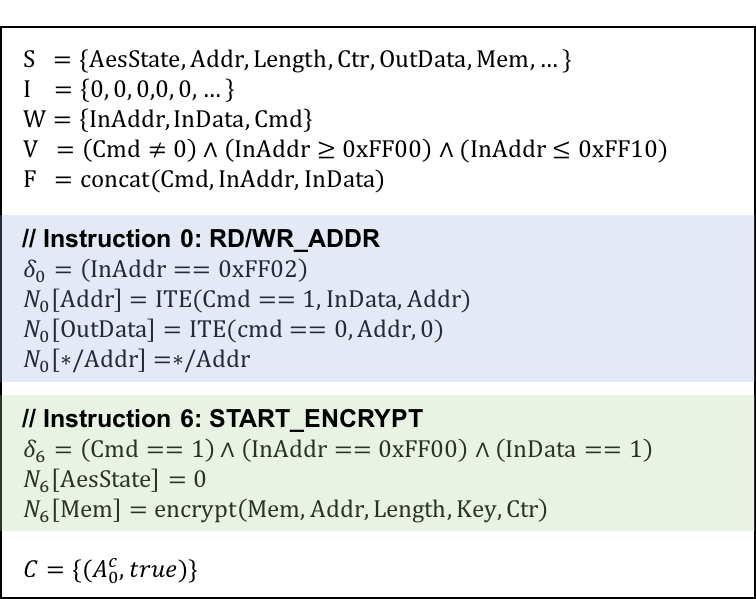-
Notifications
You must be signed in to change notification settings - Fork 4
Home
Bo-Yuan Huang edited this page May 20, 2018
·
9 revisions
Welcome to the ILA-Modeling-Verification wiki!
We will give a brief tutorial on how to write an ILA model using the Python API, with the AES example described in the arXiv paper. The below figure shows the (partially described) model of the AES ILA.

- Create an ILA model.
import ila
m = ila.Abstraction('aes')- Specify the set of architectural states. There are three types of state variables supported in the Python API, i.e., Boolean (bit), bit-vector (reg), and array (mem).
AesState = m.reg('AesState', 2) % model the AesState as a 2-bit bit-vector
Addr = m.reg('Addr', 16) % model the Addr as a 16-bit bit-vector
Length = m.reg('Length', 16) % model the Length as a 16-bit bit-vector
OutData = m.reg('OutData', 8) % model the OutData as a 8-bit bit-vector- Specify the set of input variables.
InAddr = m.inp('InAddr', 16)
InData = m.inp('InData', 8)
Cmd = m.inp('Cmd')- Define the valid and fetch function.
m.valid = (Cmd != 0) & (InAddr >= 0xFF00) & (InAddr <= 0xFF10)
m.fetch = ila.concat([Cmd, InAddr, InData])- Now let's start defining the instructions. We will take the RD/WR_ADDR instruction as the example.
% decode function
decode_0 = (InAddr == 0xFF02)
% next state functions (of two state variables)
next_addr_0 = ila.ite(Cmd == 1, InData, Addr)
next_out_data_0 = ila.ite(Cmd == 0, Addr, 0)- After all instructions are specified, set the decode functions and (cumulated) next state functions to the ILA model.
m.decode_exprs = [decode_0, decode_1, ...] % specify the list of decode functions
m.set_next(Addr, next_addr_all) % the next state function of Addr
m.set_next(OutData, next_out_data_all) % the next state function of OutDataThis is a simplified tutorial, a complete ILA model of the AES accelerator can be found in AES-ILA.